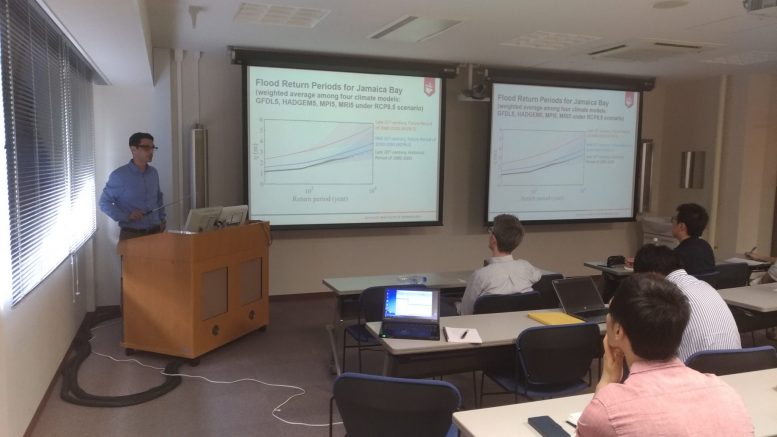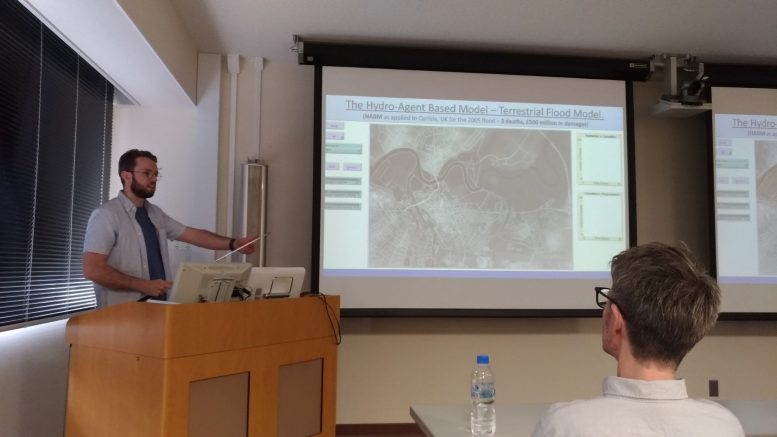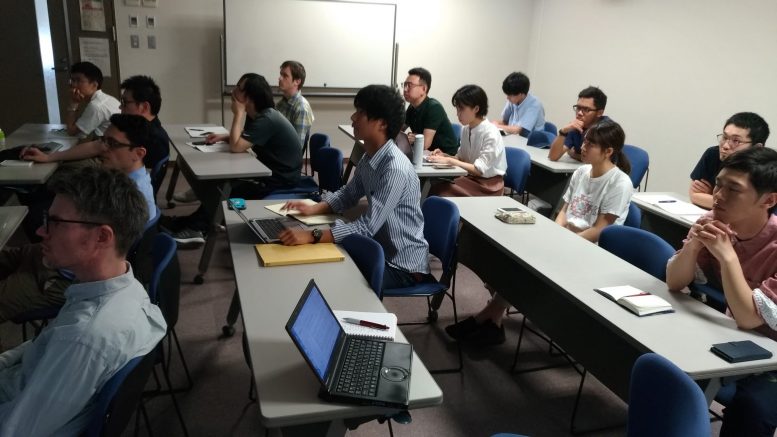Seminar: Flood simulation
- Date: June 3
- Time: 15:00-17:00
- Location: E-517D
- Contents
- Local to Basin Scale Hurricane Flood Hazards in a Changing Climate (30 min)
- Reza Marsooli (Stevens Institute of Technology, USA)
- Numerical Modeling of Tsunami Inundation in Urban Area using Sub-Grid Scale Drag Force Mode (20 min)
- Nobuki Fukui (DPRI, Kyoto University)
- Exploring disaster science using agent based modelling (20 min)
- Thomas O'Shea (University of Bristol, UK)
- Local to Basin Scale Hurricane Flood Hazards in a Changing Climate (30 min)
- Abstracts
- Reza Marsool
- Storm surges and waves generated by tropical cyclones (TC), especially hurricanes/typhoons, are among the costliest and deadliest coastal hazards. Higher sea levels and stronger (and more frequent) TCs due to global warming could worsen the present-day storm surge and wave hazards. It is necessary to understand how such hazards respond to climate change, if we are to plan and implement effective flood adaptation strategies. This talk focuses on the development, validation and application of computational models to study hazards associated with storm surge, wave and coastal flooding. In the first part of the talk, I present and discuss the spatial variation of storm surge and wave heights induced by historical hurricanes in the western North Atlantic Ocean. The second part of the talk focuses on the impact of sea level rise and TC climatology change on flood hazards in the end of 21st century. I present and discuss future changes in hurricane flood return periods along the U.S. Atlantic and Gulf (of Mexico) Coasts. The last part of the talk focuses on the impact of climate change on local-scale hurricane storm surge and wave hazards in Jamaica Bay – a highly urbanized lagoonal estuary in New York City. I present and discuss the effects of sea level rise on surface waves and the extent of coastal flooding over the bay’s floodplains.
- Nobuki Fukui
- Numerical simulation of tsunami inundation using high-resolution topography (resolution is less than 1m) needs to consider the effect of structures on wave run-up. However, numerical simulation with medium resolution (resolution over 50m to 100m) is still important for practical use due to computational cost. This study developed Drag Force Model (DFM) and individual Drag Force Model (iDFM) as an urban roughness parameterization to obtain acceptable accuracy in medium resolution tsunami inundation model based on physical modeling. The model treats the effect of structures as grid-averaged drag force and projected area in x and y-direction in Cartesian coordinate and characteristic structure height are used as parameters representing the sub-grid scale structure. Furthermore, iDFM considers the number of structures and structure height in the area of interests individually. The edge detection technology for image processing tool is used to count the number of structures. Moreover, various mesh size 10cm to 40cm are used to check mesh size dependency. The validation DFM and iDFM is conducted using numerical simulation and physical modeling of tsunami inundation targeting available tsunami inundation experiments.
- Thomas O'Shea
- We are living in uncertain times of increasing vulnerability to natural hazards. Current global loss estimate data for natural disasters (NOAA, 2017) reveal a continual trend of increasing catastrophe-related losses since 1950. In the UK, losses due to natural hazards are primarily attributable to flooding (ABI, 2017). The reasons for these trends are many, including the concentration of increasing populations and critical infrastructure in urban areas, the development of exposed coastal regions and flood plains, the high vulnerability of complex modern societies and technologies and changes in the natural environment itself, including the possible impacts of climate change. Which of these reasons is most influential on the trends is uncertain and therefore, a robust framework for decision-making under uncertainty becomes “a vital tool in what is an era of post-normal science, wherein facts are uncertain, values in dispute, stakes high and decisions urgent” (Hulme, 2009, Hill et al., 2012).Here outlined is the research undertaken for the development of a relatively robust and systematic, multi-disciplinary, modelling framework (the Hydro-Agent Based Model, ‘HABM’) for analysing and evaluating the nature of vulnerability to, and capacity for, flood hazard within complex modern societies. This framework possesses the scope to go beyond the current aggregative assessment systems for flood risk, by establishing the traditional sub-systematic parameters of environmental risk and then using these to model enhanced metrics for the influence of affected individuals’ responsive decision making in the origination of further, potentially influential, emergent behaviours within the hazard system which will, ultimately; contribute to a disaster or it’s avoidance.
- Reza Marsool



